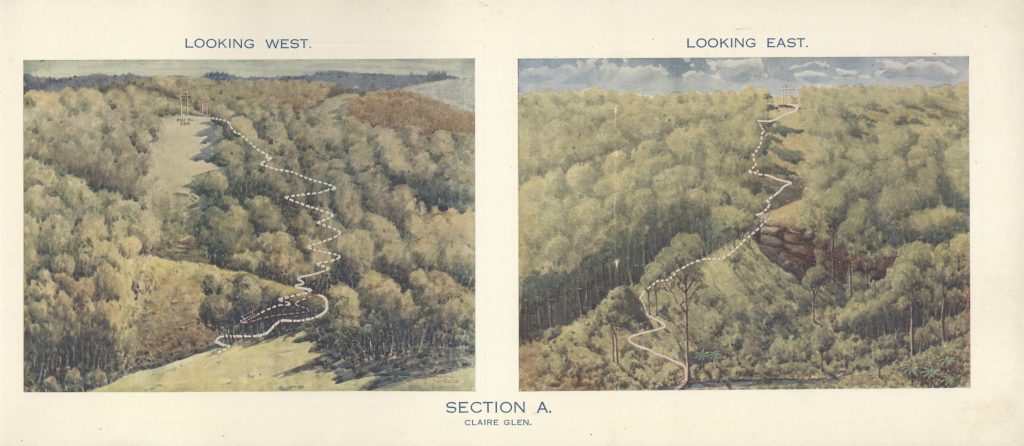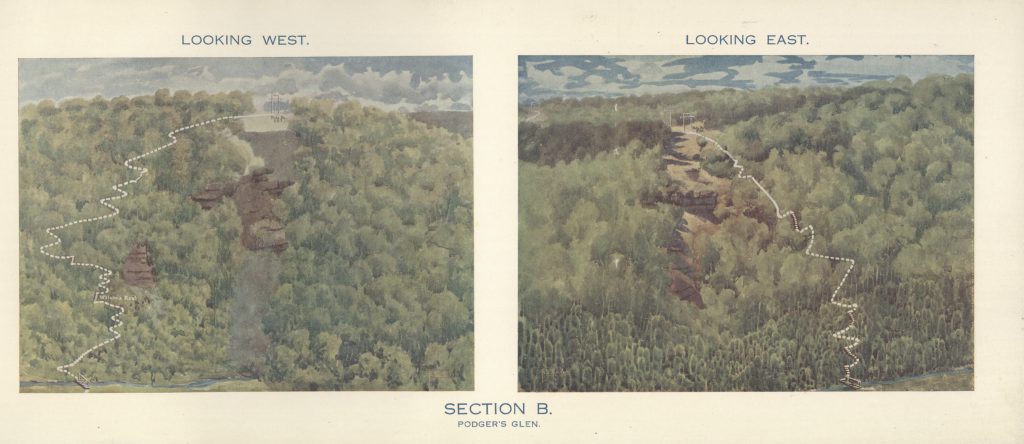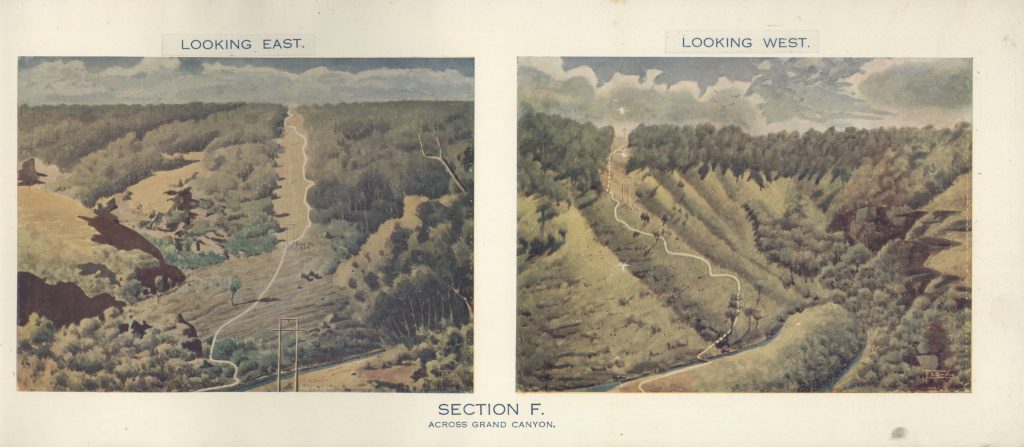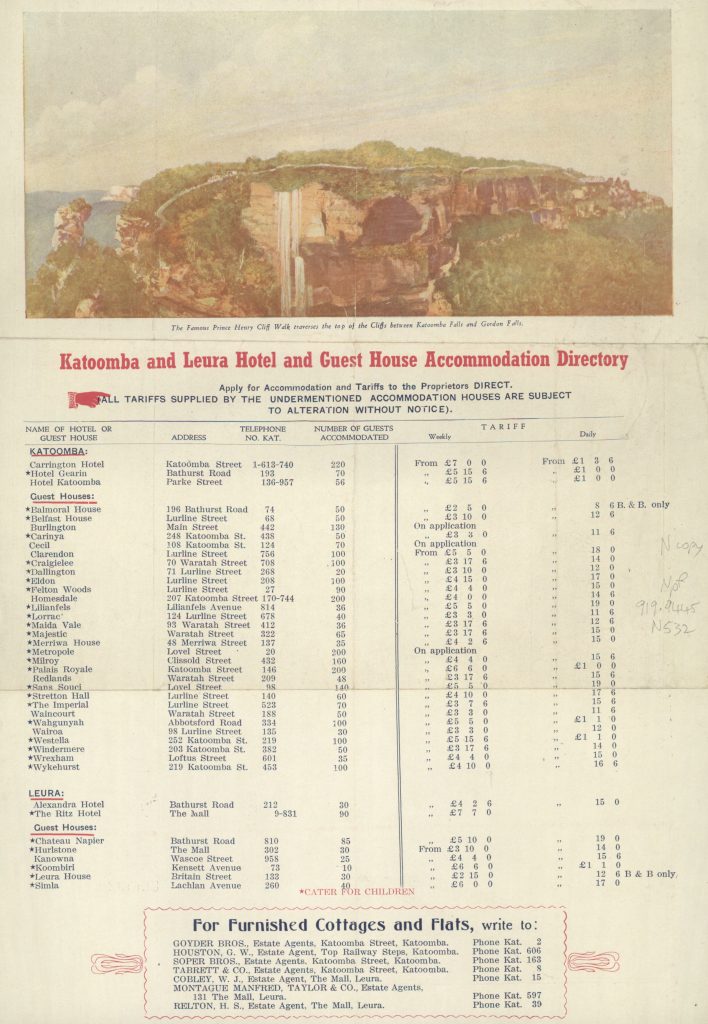In 1931 following the installation of High-Tension Electricity Line between Lawson Sub-station and Blackheath they formed a “unique tourist walk” (bushwalk) to follow the line.
They said “The idea was recently conceived of increasing the popularity of the Blue Mountains as a tourist walk. The walk was named “Bruce’s Walk” after the surveyor who selected the route.
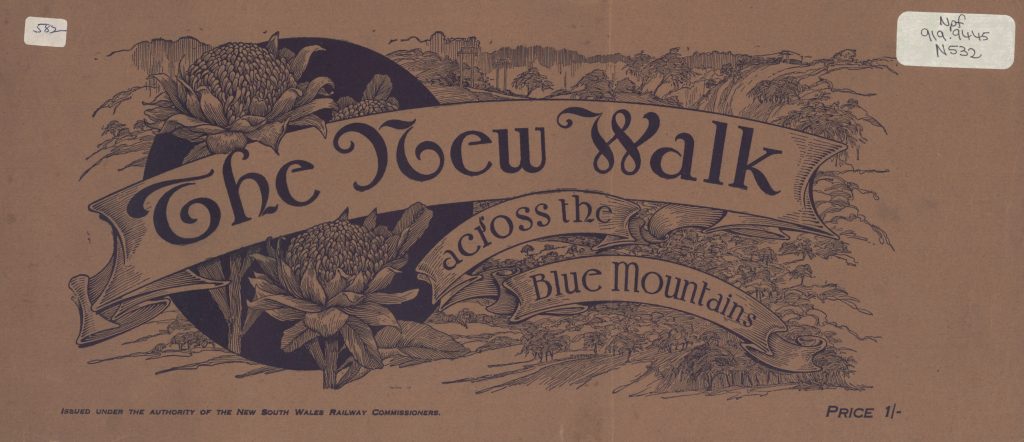
The following is information from the Tourist Booklet.
The tourist booklet said:
“In issuing this booklet, descriptive of the enchanting ‘New Walk across the ‘Blue Mountains, the ‘Railway Commissioners invite special attention to the fast and frequent train services available to Tourists for visits to these world famous mountain resorts. these train services are fully set out in the ‘Railway ‘Public Timetable, a handy work of reference indispensable to train travellers.
It will be seen that the ‘New Walk can be traversed readily, even in one day, by a selection of convenient trains, any one of which will set down Tourists at any chosen station, from which they may visit any one or all of the beauty spots of the New Walk, via the roadways shown on the key diagram presented herewith.”
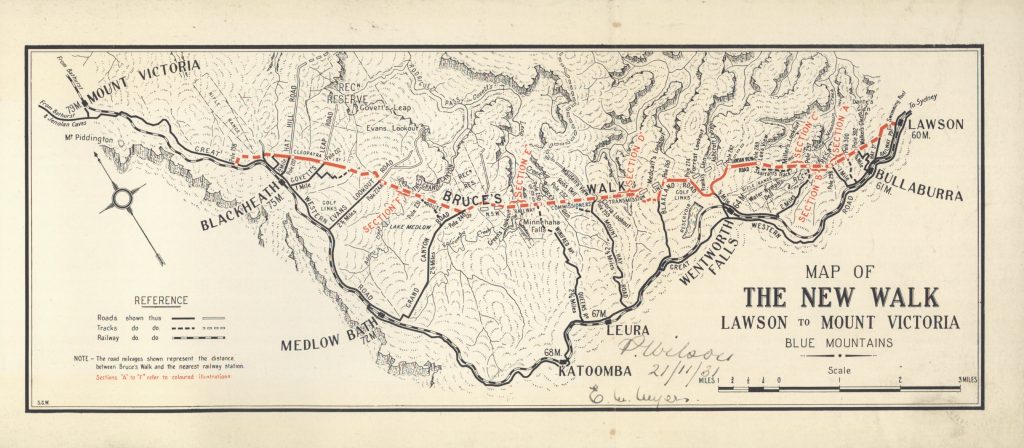
THE NEW WALK, LAWSON TO MOUNT VICTORIA
In connection with the bulk supply of electricity by the Railway Commissioners of New South Wales to the Blue Mountains Shire Council, a high-tension transmission line erected between the Commissioners’ power station at Lithgow and substation at Lawson, a distance of 28 miles, was officially placed in service on Ist July, 1931.
The line has been erected along, or in close proximity to, the Great Western railway between Lithgow and Blackheath, and across rugged virgin country, almost in a direct line, between Blackheath and Lawson. The distance along the latter section (12 miles) is 4 miles less than the distance by rail.
All timber within 50 feet of the line has been cleared as a protection from bushfires, and access along the line has been made easy for the Chief Electrical Engineer’s maintenance staff by the construction of graded tracks and the erection of bridges over creeks.
The line passes many natural beauty spots for which the Blue Mountains are famed, and, incidentally, a unique tourist walk has been established simultaneously with the completion of an important engineering undertaking.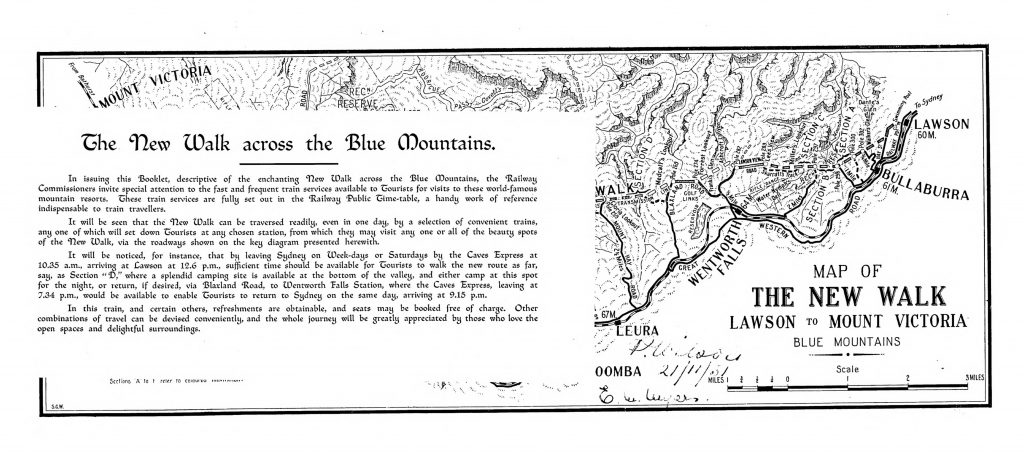
The idea was recently conceived of increasing the popularity of the Blue Mountains as a tourist resort, by giving publicity to the walk as a new scenic attraction. To assist in achieving this object, it has been decided to publish this guide, in which endeavour lias been made, with the aid of pictured representations, to describe in some measure the region traversed between Blackheath and Lawson, designated “ Bruce’s Walk.” This name has been applied as a tribute to the departmental surveyor who selected the route for the transmission line, and carried out all the necessary survey work in connection therewith.
At the instance of the Blue Mountains Shire Council, the names of some of its councillors, residents of the shire, administrative staff, and certain officers of the Railway Department immediately connected with the work of construction, have been associated with several outstanding beauty spots.
The walk should make a special appeal to “ hikers.” It is easily reached along made roads or trafficable bush tracks from Lawson, Bullaburra, Wentworth Falls, Leura, Katoomba, Medlow Bath, and Blackheath. It leads through a succession of mountain brooks, fern gullies, and prominent peaks commanding extensive panoramic views. Over the whole region is a dense growth of native flowering shrubs which, in season, present a wealth of colouring and fill the air with that fragrant charm which is peculiar to the Australian bush.
Animal and bird life indigenous to the Blue Mountains are present in greater numbers in this undisturbed region than in the more frequented tourist resorts.
The most charming spots along the walk will be found in the gullies, but bush lovers will observe interesting features on every hand.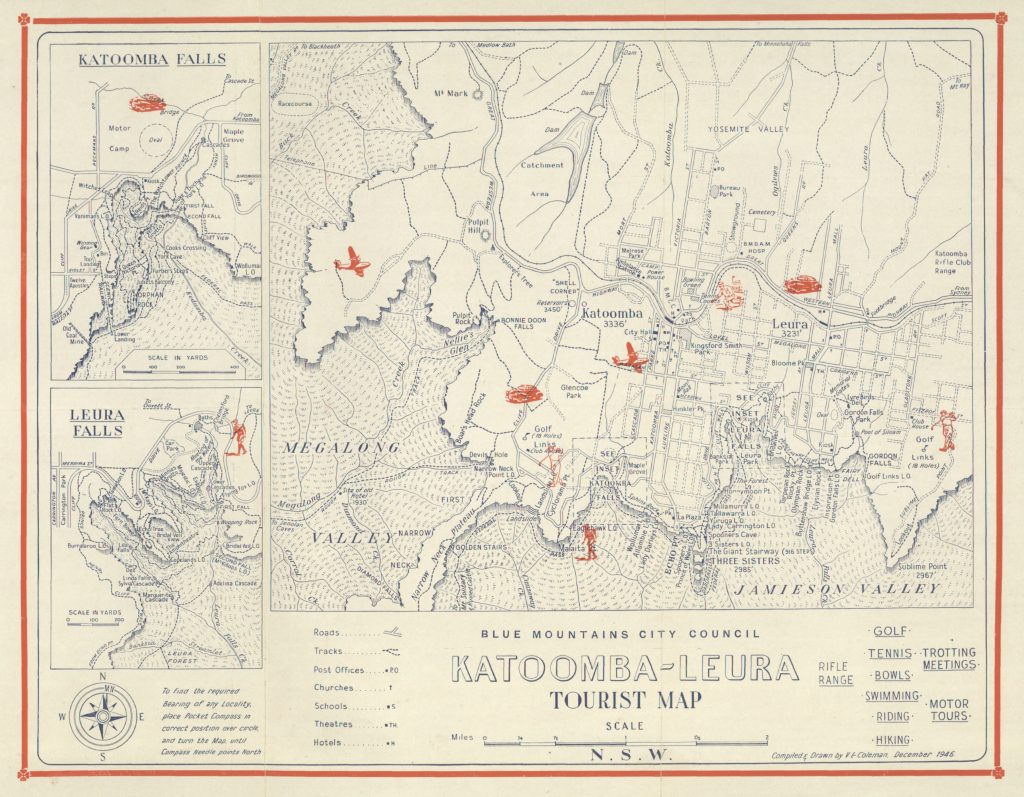
LAWSON
Commencing at Lawson, the first attraction is WILSON PARK, situated directly opposite the Commissioners’ substation. This is a delightful spot, embracing an area of 20 acres of bushland, improved by the Blue Mountains Shire Council by the construction of paths, the planting of ornamental trees, shrubs, and grasses, the erection of shelter sheds, tables and seats, and the provision of a domestic water supply.
Nestling in a natural depression in the centre of the park, and distant approximately 300 yards from the railway station, is a fine SWIMMING POOL 100 yards in length, 70 yards in width, and 6 to 12 feet in depth. All necessary conveniences are provided for bathers, e.g., club house, dressing sheds, showers, springboards, sunbaking platform, lifesaving apparatus, large enclosed safety area for children, and a measured racing track 50 yards in length.
There is also a refreshment kiosk from which, also, bathers’ requisites are obtainable, and a large area has been set aside for the parking of motor cars. The park is named after Councillor Percy Wilson, the President of the Shire, at whose instance both the above work and many others in the shire were initiated and developed.
BULLABURRA
Passing Wilson Park the transmission line follows along Hay Street to pole No. 305 in Wallis Street, where a track turning sharply left follows a gentle descent into WALKER’S GLEN, which is distant three quarters of a mile from Bullaburra Railway Station along Bullaburra Road, and a short length of bush track. Open spaces, shady trees, and good drinking water make this a natural picnic and camping ground within fifteen minutes’ walk from the station. Forty yards north along the creek is a small cave suitable for temporary shelter in an emergency.
From Walker’s Glen the track ascends a hill to pole 300. A bush road, trafficable by car, leads to Bullaburra from this point, the distance being three quarters of a mile.
Descending the hill onward from pole 300 (section “A”), CLAIRE GLEN, named after the wife of the Shire President, a picturesque spot at the junction of two creeks, is approached. Here the track winds among overhanging rocks, tall blue gums and giant tree ferns. A feature of this and other gullies crossed is the bird life, which is not apparent along the ridges. Good drinking water and camping sites are available in the glen.
The track then zigzags up the hill through a mass of ferns and undergrowth to pole 299, from which point striking echoes are obtained facing eastward.
From pole 298 the track leads into PODGER’S GLEN (section “B”), a secluded narrow glen walled in by precipitous mountainsides clad with a luxuriant growth of a native flora. A bridge is crossed just below the junction of two crystal brooks, bordered with a mass of beautiful ferns and tall coachwood and sassafras trees, whose overhanging foliage interlaced with vines provide sheds and shelter to the ferns and mosses below. The water here is good for drinking, and there is sufficient shelter for a small party under an overhanging rock nearby (western side, about 50 feet north of bridge).
WENTWORTH FALLS.
Ascending the western side of Podger’s Glen (past WILSON’S PEST, which overlooks the glen from a prominent point halfway up the mountain side), the highlands are again reached at pole 297. From this point a car road leads to Wentworth Falls Station, distant 2 miles.
Continuing along the walk the grade is fairly level to pole 295. Here the track hears to the right into BURGESS GLEN (section “C”). From the glen it turns back to the left and follows upward for some distance along the foot of a line of cliffs to a bridge crossing a rapid stream, swishing over waterworn holes and boulders.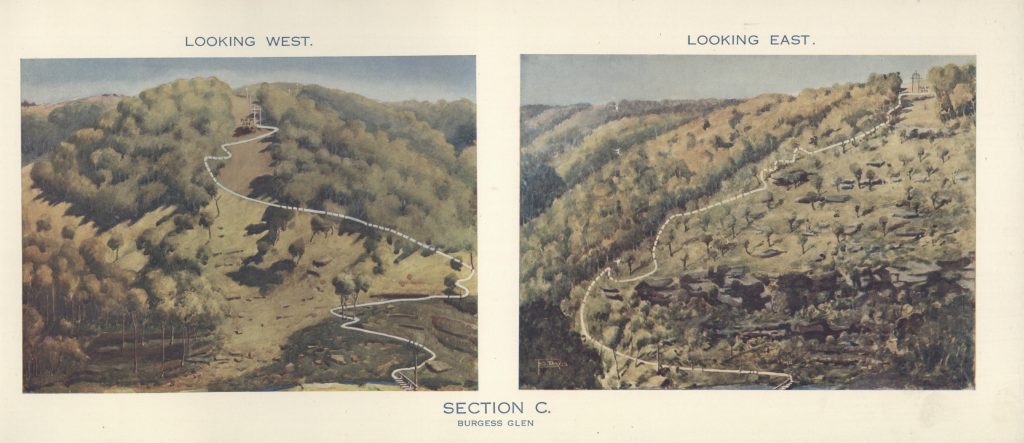
On each side of the creek are precipitous cliffs. The walk through the glen is a pleasant one, and good views are obtained from all points along the track. After crossing the bridge the track curves round a number of huge boulders up a fairly steep gradient to MILLER’S LOOKOUT near pole 294.
A permanent supply of good drinking water is available in Burgess Glen, and several caves adjacent to the track on the eastern side of the glen would, if required, afford temporary shelter.
From Miller’s Lookout onward along SKARRATT’S TRACK to LEE’S VIEW (pole 289) the gradient is easier. From Lee’s View a fine panoramic vista is obtainable, extending away as far as the heights north of Sydney and the sandhills at Botany Bay. In the foreground, the lowlands beyond Penrith are seen, and on a clear day the Sydney Harbour Bridge can be discerned with the naked eye.
Onward from this point the transmission line has been erected along Lawson ViewRoad and Lurline Street, Wentworth Falls, to pole 279. Thence it crosses ASHCROFT CANYON and FRANKI’S GLEN (between poles 277 and 276). From pole 276, FORREST LOOKOUT, a panoramic view similar to that from Lee’s Lookout is obtained, whilst on the left Mount Hay and Mount Tomah are to be seen shrouded in a light blue haze. Tourists are advised to take theRoad turning to the left at pole 282 and thence along Blaxland Road to Forrest Lookout, as no track has been made across Ashcroft Canyon and Franki’s Glen.
From Forrest Lookout to Medcalf’s Lookout (pole 265) the route is mainly along Blaxland Road.
MEDCALF’S LOOKOUT overlooks Heffernan’s Valley, and from here a comprehensive view of the transmission line is obtained as it sweeps across the valley in long symmetrical spans to Gloria Lookout. Tourists intending to proceed onward from this point are recommended to retrace their steps back to BlaxlandRoad, turning to the right and at a point one quarter of a mile towards Leura following the track leading to the right off BlaxlandRoad. This will provide easy walking to pole 262.
From here the track bears to the right and curves around a steep, rocky spur which slopes into a clear mountain stream flowing through HEFFERHAH’S VALLEY (section “D”), This stream comprises excellent drinking water, and higher up the slopes of the valley suitable camping sites will be found.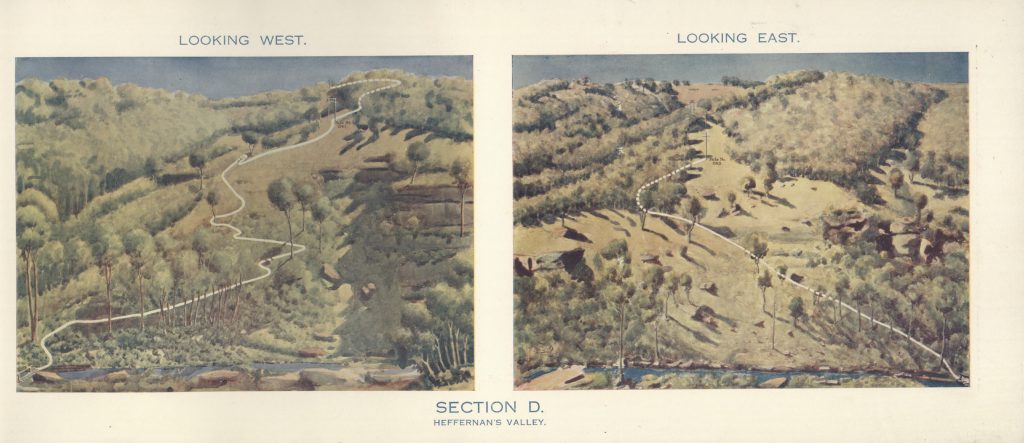
Boy Scouts or other parties requiring extensive camping space should specially note this. Those fond of rambling will delight in exploring the stream down among beautiful pools, miniature cascades, moss covered rocks and clumps of ferns nestling in shady nooks. Overhead the towering blue gums add to the surrounding beauty and provide shelter to the ferns below. About 200 yards down the stream from the bridge is a NATURAL SWIMMING POOL containing crystal clear water and a sandy bottom. Opposite the bridge just above the creek bed on the western side is a good shelter cave.
Leaving the creek the track continues on to Gloria Lookout at pole 259. The gradient to this point is fairly steep, but if the tourist proceeds quietly over this region he may hear or see the Lyre Bird, noted for its beautiful tail and extraordinary powers of mimicry, this valley being one of its most favoured haunts.
LEURA
GLORIA LOOKOUT, named after the daughter of the Shire President, is one of the highest points of observation. Looking eastward an expansive view across the Dividing Range is obtained, Eastwood to Botany Bay being visible along the horizon. From this point a trafficable bush road (Mount Hay Road) connects with the Great Western Road at the Leura Public School, distant about 2 miles proceeding onward from Gloria Lookout past MAIDER’S VIEW (looking west from pole 258) and ROSS DELL (looking north from pole 252) a tract of very barren country is crossed, the soil being too poor in places to support timber growth.
Good water and shelter are available near pole 255, and there is a large area in this locality suitable for camping.
From pole 252 a good bush road on the left connects with the Mount Hay road leading to Leura
GRACE’S GLEN lies between poles 252 and 251. It comprises a broad, exposed gully, the lower part of which is either timberless or sparsely timbered with stunted gum.
A permanent supply of good drinking water is available in Govett’s Leap Creek, which flows through the glen. Some clear pools and small cascades are to be seen along the creek.
KATOOMBA
From pole 248 on the eastern side of DELAHEY’S VALLEY (section “ E ”) onward to Green’s Lookout is one of the most delightful sections. A winding path leads into a deep walled gorge through which flows Katoomba Creek. Along the creek are many beautiful pools, fantastically shaped rocks and numerous varieties of ferns.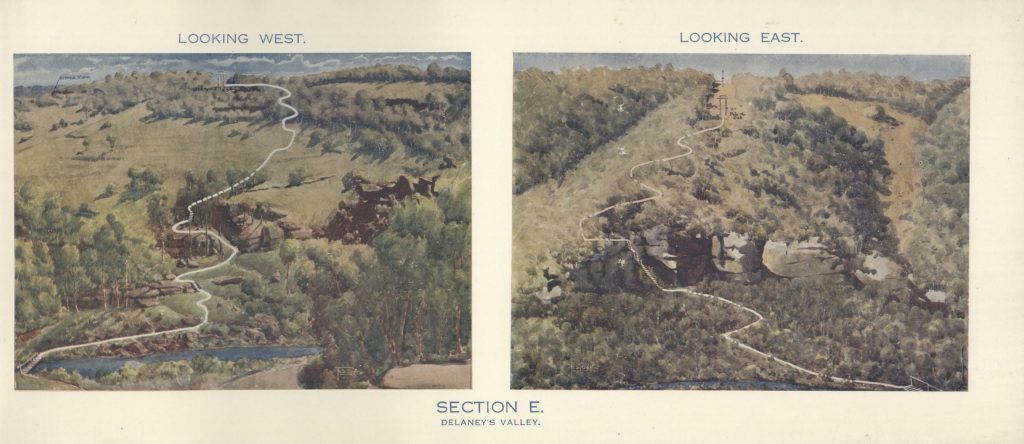
Beyond the ferns are stately blue gums and stringybark trees intermingled with a thick undergrowth of wattle and other flowering shrubs. In the background is a precipitous line of cliffs forming an almost impassable barrier.
THE WATER IN KATOOMBA CREEK IS NOT SUITABLE FOR DRINKING, but if the creek is followed upward along the eastern side a small stream of good drinking water will be found about 150 yards from the bridge. On the opposite side of the creek, and 50 yards from the bridge, there is a good shelter cave.
MEDLOW BATH
After crossing Katoomba Creek the climb is steep in places until GREER’S LOOKOUT is reached, about 70 yards to the left of pole 247. From this point a fine view across the valley is obtained, and the head of Katoomba Creek is seen glistening in the sunlight as it flows over a stretch of bare rocks. Lower down its course is broken by the famous Minne-lla-Ha Falls, which can be clearly seen from this point. To the left of the falls is a long line of those perpendicular cliffs for which the district is famous, forming a crescent shaped bay in the mountainside.
From Green’s Lookout the track gently ascends, bears to the right near pole 244, meeting the transmission line again near pole 240. Here a more fertile tract of country is encountered, and a multifold variety of wildflowers and a wealth of beautiful foliage are its outstanding features. The visitor may be fortunate enough to catch a glimpse of a few kangaroos, now practically exterminated in the more frequented tourist resorts.
BLACKHEATH
If the tourist desires to return from this point the road straight ahead leads to Medlow Bath Station. It is traffiable by car, the distance being 2J miles. If it is intended to continue along the walk, turn sharply to the right along the bush track, distant about half a mile from pole 240 towards Medlow Bath. This track, which is trafficable by car, meets the transmission line again at pole 231, the distance thereto being about half a mile from the turn off.
Alternatively, the transmission line may be followed from pole 240. There is no made track along this route, but the walking is fairly good, being along a gentle slope downwards to the GRATED CARYOR (section “F”).
At the bottom of the canyon a track will be seen crossing the transmission line and following along the creek. The tourist has the choice of two tracks leading to Blackheath from this point. Turning sharply to the left and following up the creek, the walk is a delightful one, passing the famous Wall’s Cave, where the creek flows underground.
A shorter route is along the transmission line track. This turns to the right along the creek for a short distance, then crosses the creek and zigzags up the hill to Evans’ Lookout road. If it is desired to see more of the Grand Canyon and Reate’s Glen, the tourist should continue along the track following the creek downwards.
At Evans’ Lookout road turn to the left for Blackheath, which is distant about 2J miles along a made road.
From Evans’ Lookout road onward nothing of special interest is to be seen. The transmission line continues onward to Cleopatra Street, thence through the town of Blackheath, joining the Great Western Road about 1 mile beyond Blackheath Railway Station. From here onward it has been erected in close proximity to the railway line, terminating at the Power Station, Lithgow.
In connection with this introduction to Bruce’s Walk it might be mentioned that no comparison is made of its merits as a scenic attraction with those grand, majestic, and world famous lookouts to be seen elsewhere on the Blue Mountains. The new route, however, possesses a charm of its own and offers 12 miles of delightful walking over a little known region, which will be greatly appreciated by walking enthusiasts and picnickers, especially when the wildflowers are blooming. The roadways leading to the route of the transmission line, shown on the keymap in the folder, are all available for motor cars, providing easy access for picnickers to the pathways of the valleys shown on the coloured diagrams.
To those who are unable, or are disinclined, to walk the full length of the route, it is suggested that a selection of one or two of the valleys be made for picnicking. The tourist can, of course, make a short circuitous walk, starting from any of the railway centres shown on the keymap, passing along the roadway to the transmission line, thence via the valley or valleys desired, and returning to an adjoining railway station. The road distances are shown on the keymap, and fingerposts liberally installed at various points throughout the route and at branches off the Main “Western Road.

